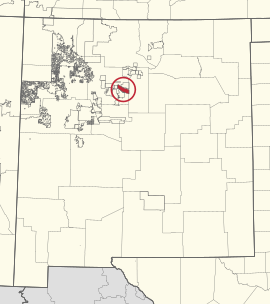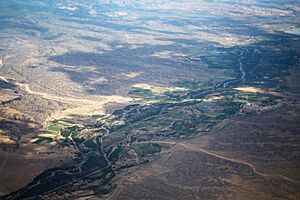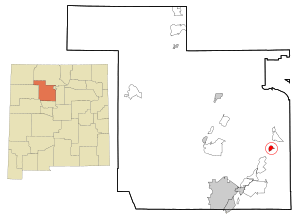Santo Domingo Pueblo, New Mexico facts for kids

Location in Sandoval County
|
|
| Total population | |
|---|---|
| 3,519 | |
| Regions with significant populations | |
| Languages | |
| Keres, English |
|
Santo Domingo Pueblo
|
|
|---|---|

Aerial image of Kewa Pueblo
|
|

Location in New Mexico
|
|
| Country | United States |
| State | New Mexico |
| County | Sandoval |
| Area | |
| • Total | 2.05 sq mi (5.32 km2) |
| • Land | 2.04 sq mi (5.28 km2) |
| • Water | 0.01 sq mi (0.04 km2) |
| Elevation | 5,187 ft (1,581 m) |
| Population
(2020)
|
|
| • Total | 2,311 |
| • Density | 1,133.95/sq mi (437.78/km2) |
| Time zone | UTC-7 (Mountain (MST)) |
| • Summer (DST) | UTC-6 (MDT) |
| ZIP code |
87052
|
| Area code(s) | 505 |
| FIPS code | 35-70810 |
| GNIS feature ID | 0928818 |
|
Pueblo of Santo Domingo (Kiua)
|
|
 |
|
| Lua error in Module:Location_map at line 420: attempt to index field 'wikibase' (a nil value). | |
| Nearest city | Albuquerque, New Mexico |
|---|---|
| Area | 48 acres (19 ha) |
| Built | 1700 |
| Architectural style | Mixed (more Than 2 Styles From Different Periods), Pueblo |
| NRHP reference No. | 73001145 |
| Added to NRHP | December 12, 1973 |
Santo Domingo Pueblo, also known Kewa Pueblo (also spelled Kiua, Eastern Keres [kʰewɑ], Keres: Díiwʾi, Navajo: Tó Hájiiloh) is a federally-recognized tribe of Native American Pueblo people in northern New Mexico. A population of 2,456 (as of 2010) live in structures some of which date from circa 1700; in Sandoval County (~35 miles (56 km) northeast of Albuquerque, New Mexico, off Interstate 25 southwest of Santa Fe) described by the U.S. Census Bureau as a census-designated place.
A 48 acres (19 ha) area of the pueblo was listed on the National Register of Historic Places in 1973. The listing included 80 contributing buildings.
Contents
Culture
The population of the pueblo is composed of Native Americans who speak Keres, an eastern dialect of the Keresan languages. Like several other Pueblo peoples, they have a matrilineal kinship system, in which children are considered born into the mother's family and clan, and inheritance and property pass through the maternal line. The pueblo celebrates an annual feast day on August 4 to honor their patron saint, Saint Dominic. More than 2,000 pueblo people participate in the traditional corn dances held at this time.
Name
On the catholic saint's day of Santo Domingo in August 1598, conquistador Juan de Oñate had his first encounter with Kewa Pueblo. The Pueblo was subsequently named "Santo Domingo". Its earliest recorded name was Gipuy. According to Pueblo Council members, the local name in their Keres language has always been Kewa. In 2009, the pueblo officially changed its name to Kewa Pueblo, altering its seal, signs and letterhead.
According to the Pueblo of Acoma's Keres Online Dictionary, the Western Keresan-name for the pueblo was Díiwʾi and for its people therefore Dîiwʾamʾé.
Geography
Kewa Pueblo is located at 35°30′52″N 106°21′48″W / 35.51444°N 106.36333°W (35.514483, -106.363429). The pueblo is located approximately 25 miles (40 km) southwest of Santa Fe. Interstate 25 runs 4 miles (6 km) to the east of the community. The pueblo is part of the Albuquerque Metropolitan Statistical Area.
According to the United States Census Bureau, the Santo Domingo CDP that overlays the pueblo has a total area of 2.0 square miles (5.2 km2), all land.
Demographics
| Historical population | |||
|---|---|---|---|
| Census | Pop. | %± | |
| 2020 | 2,311 | — | |
| U.S. Decennial Census | |||
The 2010 census found that 2,456 people lived in the CDP, while 3,519 people in the U.S. reported being exclusively Santo Domingo Puebloan and 4,430 people reported being Santo Domingo Puebloan exclusively or in combination with another group.
The state of New Mexico has reported the population as 3,100.
History
The pueblo plays a supporting role in Spanish colonial history. Francisco Vázquez de Coronado made first contact with Kewa in 1540. When the Spanish first came to the Rio Grande Valley, they found over 70 villages that manufactured goods and had a strong trade network. Kewa was one of these villages. After first contact, Spanish expeditions into the area continued, one of them being Juan de Oñate's expedition in 1598. Oñate arrived in Kewa Pueblo with the intention of bringing Kewa and pueblos in its vicinity under Spanish rule. Soon after his visit, a mission was established and a church was built. In 1680, Kewa and other nearby pueblos rose in revolt against their Spanish colonizers, killing four priests and Spanish settlers nearby. Similar strife occurred again during the tail end of Spanish colonization in the area in 1696. In both cases, the revolts were eventually quelled by the Spanish. A century later, in 1807, Lieutenant Zebulon Pike visited Kewa. In his journal, he described the church as adorned with elegantly ornamented paintings, one of which being Saint Domingo.
Gaspar Castaño de Sosa, a fugitive from the Crown, was arrested at the pueblo in March 1591. Castaño, a notorious slaver, had fled capture. He pursued an illegal claims expedition up the Pecos River, which had not yet been seen by Europeans. He made it as far as Pecos Pueblo, and raided it for slaves. He turned west and traveled toward modern-day Santa Fe, which had been established by the Spanish. He followed the Rio Grande river valley south. On orders of the Viceroy at Mexico City, Captain Juan Morlette found Castaño at Kewa Pueblo and arrested him. He returned him to authorities to face trial for his crimes, including his attack on Pecos Pueblo.
Castaño abandoned two interpreters at Kewa Pueblo; he had kidnapped them earlier and brought them with him. Governor Juan de Oñate's expedition recorded encountering Tomas and Cristobal at Kewa Pueblo, as it traveled north.
20th century to present
Potters of Kewa and Cochiti Pueblos have made stylized pottery for centuries, developing styles for different purposes and expressing deep beliefs in their designs. Since the early decades of the 20th century, these pots have been appreciated by a wider audience outside the pueblos. Continuing to use traditional techniques, in the late 20th and early 21st centuries, potters have also expanded their designs and repertoire in pottery, which has an international market.
Belief System
Kewa Indians, similar to other Indian populations in the Rio Grande region, believe their people emerged from the inner earth from a place in the north called Shipap. As the legend goes, from Shipap they migrated southwards, breaking off into smaller groups along the way. These breakaway groups would go on to found other pueblos.
Visual arts
Kewa artists are known for their stonework jewelry, including flat disks or beads called heishi, meaning "shell bead" in Eastern Keresan, which are often made into necklaces.
Pottery
Pottery is an important art form and utilitarian craft from Kewa Pueblo. Large ollas and dough bowls are common forms for Kewa potters. Many Kewa potters are women, although men can also create ceramics. In the 1920's, tourism catalyzed by a nearby railway stop in the town of Wallace, drew attention to Kewa and its pottery. Pottery would become a valuable export for Kewa during this time.
The Aguilar Family, consisting of two sisters and one sister-in-law, created Kewa pottery from 1910 until approximately 1915 and became very well-known for their artwork.
Robert Tenorio has continued his family legacy by making traditional Kewa pottery, and Tenorio's sister was part of a well-known husband-wife pottery collaboration called, Arthur and Hilda Coriz.
Education
It is in the Bernalillo Public Schools district, which operates Santo Domingo Elementary and Middle Schools, and Bernalillo High School.
The school district states that Cochiti Elementary and Middle Schools in Peña Blanca and Bernalillo Middle School have students from Kewa Pueblo. Bernalillo Middle School (a zoned middle school of this community), Some elementary-aged students from Kewa Pueblo attend Algodones Elementary School in Algodones.
Notable people
See also
 In Spanish: Pueblo Kewa para niños
In Spanish: Pueblo Kewa para niños



